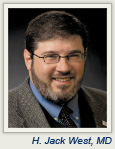Accumulating data are helping to better define the risk-benefit profile of various adjuvant chemotherapy regimens for non–small cell lung cancer (NSCLC) and the impact of adding biologic agents to the mix, according to H. Jack West, MD, of the Swedish Cancer Institute in Seattle.
In the randomized E1505 trial, investigators are testing the combination of bevacizumab (Avastin) with adjuvant chemotherapy in stage IB to IIIA NSCLC. Patients are given chemotherapy (any of four cisplatin doublets, at the treating physician’s discretion) with or without bevacizumab.
In an analysis reported after accrual of 636 of 1,500 planned patients, the chemotherapy regimen chosen was cisplatin/vinorelbine in 27% of patients, cisplatin/docetaxel in 33%, cisplatin/gemcitabine in 25%, and cisplatin/pemetrexed (an option added belatedly) in 16%.1
“Any of those regimens that are included in the trial are really considered to be appropriate choices,” Dr. West commented. “But speaking to the challenge of administering some of these, I will say that the reasoning behind the inclusion of these other alternatives is really an extrapolation from the metastatic setting, where we have volumes of work showing the comparability of one platinum-based doublet or another.”
Challenging Options
For example, although as efficacious as the rest, cisplatin/docetaxel is challenging to administer, as suggested by data from a phase II trial conducted at Memorial Sloan-Kettering Cancer Center.2 Between 31% and 55% of patients could not complete even the targeted three cycles of chemotherapy.
“And these are Memorial patients,” Dr. West said, noting that the regimen could be even more challenging at facilities with less fit patients and less expertise giving cisplatin regularly. “I think it’s just worth factoring into the equation of what treatment to select.”
He noted that the National Comprehensive Cancer Network (NCCN) lists eight cisplatin-containing regimens as options for adjuvant chemotherapy after resection of NSCLC, as well as an alternative carboplatin-containing regimen for patients who cannot receive cisplatin.3
As for adding bevacizumab, the E1505 trial has found a higher overall rate of grade 3/4 toxicity. But perhaps more worrisome, the rate of grade 5 toxicity was 3.8% with bevacizumab compared with 2.5% without it, though this preliminary analysis did not separate treatment-related deaths from deaths due to disease recurrence.
“That is something we should continue to follow as the trial continues and data mature,” Dr. West commented. “We want to ensure that our treatments are as safe as possible, but especially when you’re treating them and they may have already been cured by the surgery they have completed.” ■
References
1. Wakelee HA, Dahlberg SE, Keller SM, et al: Interim report of on-study demographics and toxicity from E1505, a phase III randomized trial of adjuvant (adj) chemotherapy (chemo) with or without bevacizumab (B) for completely resected early-stage non-small cell lung cancer (NSCLC). 2011 ASCO Annual Meeting. Abstract 7013. Presented June 7, 2011.
2. Azzoli CG, Krug LM, Miller VA, et al: A phase II tolerability study of cisplatin plus docetaxel as adjuvant chemotherapy for resected non-small cell lung cancer. J Thorac Oncol 2:638-644, 2007.
3. NCCN Clinical Practice Guidelines in Oncology (NCCN Guidelines™). Non-Small Cell Lung Cancer. Version 3.2011. Available at http://www.nccn.org/professionals/physician_gls/pdf/nscl.pdf. Accessed September 14, 2011.

 Data presented at the ASCO Annual Meeting this year on the management of locoregional lung cancer present a mixed picture, with some advances and some disappointments, according to H. Jack West, MD, of the Swedish Cancer Institute in Seattle, who reviewed studies in this area at the Best of ASCO...
Data presented at the ASCO Annual Meeting this year on the management of locoregional lung cancer present a mixed picture, with some advances and some disappointments, according to H. Jack West, MD, of the Swedish Cancer Institute in Seattle, who reviewed studies in this area at the Best of ASCO...